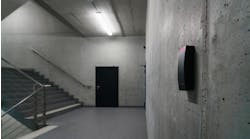Green roofs can host all sorts of amenities, from rooftop conference rooms to lush gardens. Alvéole, a turnkey urban beekeeping service, adds honeybee hives to that list. Your building’s occupants can enjoy jars of honey harvested from your own bees, who will also pollinate the plants on your roof.
Urban Beekeeping
Starting in the spring, Alvéole brings hives full of docile Italian honeybees to your building. The beekeeping team finds the best and safest location for the hives to allow the bees to thrive without having an adverse effect on your space. (Photo credit: Alvéole)
The team returns every three weeks to check on the hives and do any needed maintenance, so there’s no need to buy beekeeping suits for your facilities team.
You can also have them conduct hour-long immersive workshops to demonstrate the project to your tenants. Schools that adopt hives enjoy a more interactive process with two hour-long workshops targeted at students.
In the fall, the beekeepers harvest your honey frames, extract the honey and bottle it in the jar size of your choice. You can design a custom label to show off where your honey came from. (Photo credit: Alvéole)
The hives are insulated over the winter to keep the bee population stable until the cycle starts over again in the spring.
Why Add Bees to Your Roof?
The hives are a distinctive way to demonstrate your commitment to sustainability and healthier spaces, explains Étienne Lapierre, Alvéole’s lead urban beekeeping specialist and cofounder.
“Urban apiaries have become sought-after and desirable amenities that contribute to tenant retention and engagement. By offering healthier, greener spaces, building owners and managers contribute directly to the health and well-being of tenants, as well as substantially improving their satisfaction and the value they place on the building,” Lapierre says. “The installation of a hive in an urban environment requires minimal resources while bringing a flood of direct and indirect benefits, notably increased social and ecological welfare.”
(Photo credit: Alvéole)
The hives can also be installed at ground level—think terraces, common spaces or internal courtyards. The best beehive locations include five elements.
1. Orientation. “The hive must be placed so that the bees’ flight trajectory does not cross an area where people circulate,” Lapierre says.
2. Traffic. Put the hive in a calm environment where there’s not much human activity. The bees need space to themselves.
3. Visibility. Tenants will want to see the bees at work, and a visible hive “increases its internal and external impact and maximizes your investment,” explains Lapierre.
[Related: Four Tips for Pest Control on Green Roofs]
4. Ease of access. Make it easy for the beekeeping team to get to your hives.
5. Exposure. Bees thrive in sunny, dry locations where they’re protected from the elements and shielded from strong winds.
“It’s important to understand that honey bees are not interested in the presence of humans,” Lapierre adds. “Their daily quest is to bring nectar, pollen, resin or water to their colony to ensure its development. Unless aggression is demonstrated towards them, bees have no motivation to sting. In fact, if they sting they die.”
Learn more about BOMA 2019:



